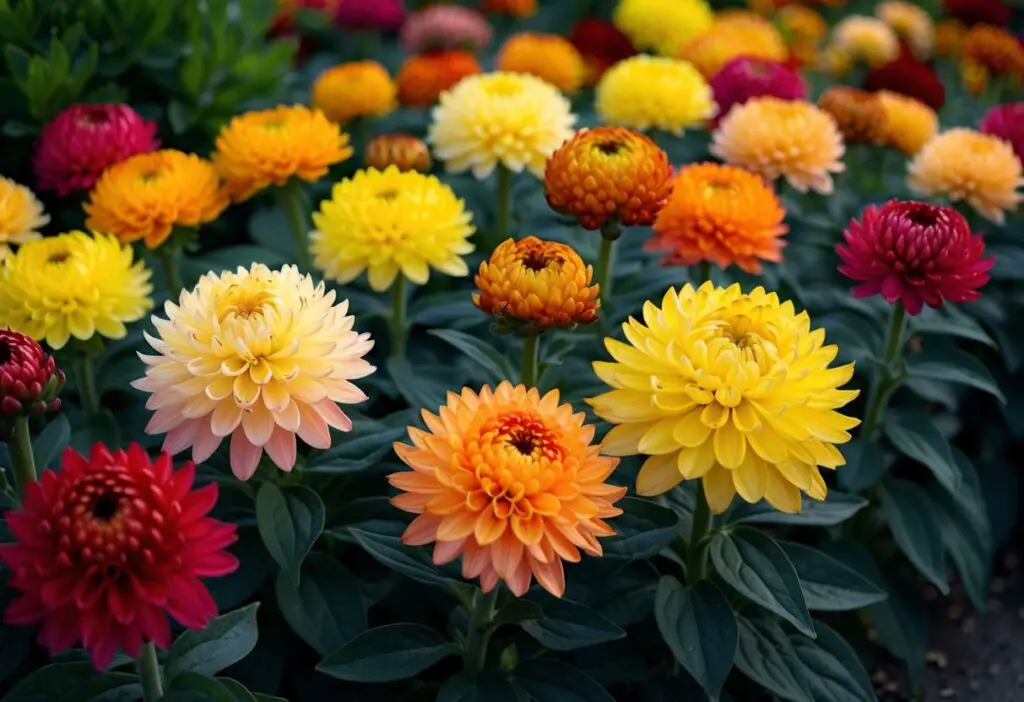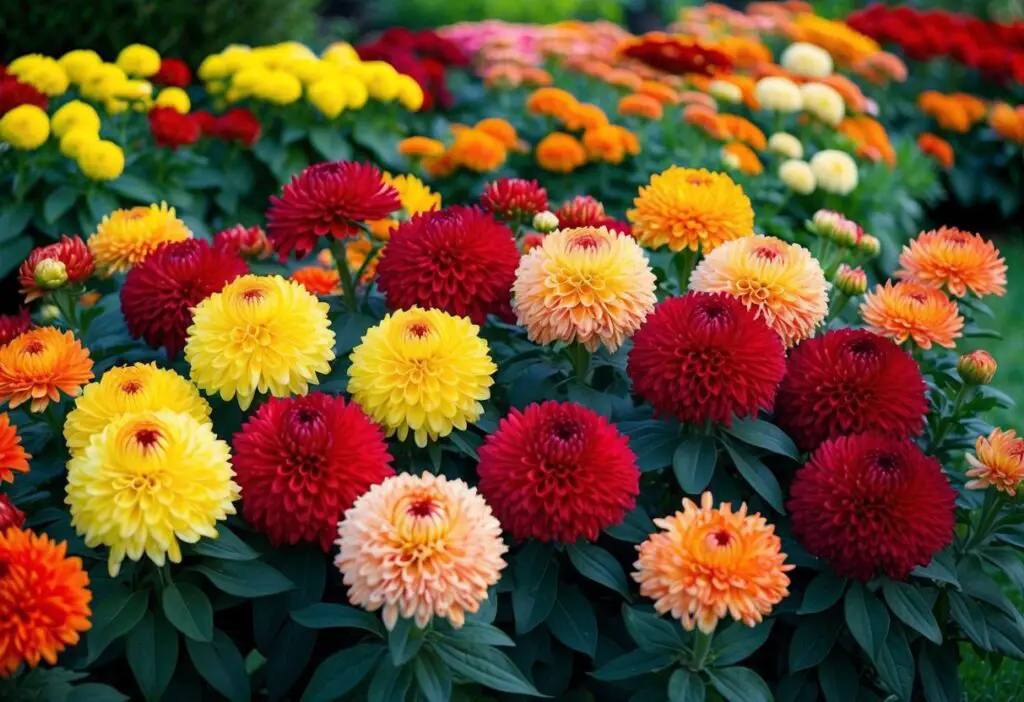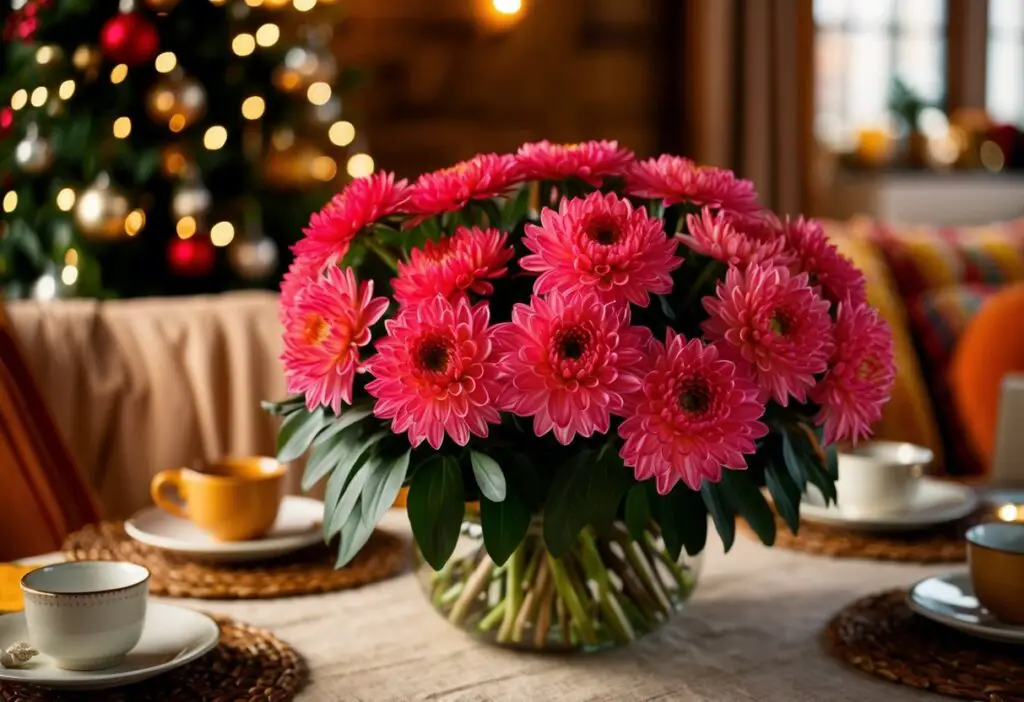Chrysanthemums are the vibrant bloomers of November, bringing joy and happiness even as autumn fades into winter. These colorful flowers, often called “mums,” are November’s birth flowers, symbolizing joy, beauty, and longevity. Why do these flowers hold such significance, and what makes them a perfect match for November’s spirit?

Imagine walking through a garden bursting with chrysanthemums in every shade—from golds and yellows to rich oranges and purples. Their bright colors and full petals add warmth to the cooler days of November. Originating from Asia, chrysanthemums are not only beautiful but also resilient, thriving best in cooler climates.
Picked for their charm and variety, chrysanthemums have become essential in expressing gratitude and joy during fall celebrations. They’ve got a history, too—the name itself comes from Greek roots, meaning “gold flower.” You might find it fascinating how a flower can embody a season so perfectly!
The Significance of Birth Flowers
Birth flowers carry cultural and symbolic meanings, often reflecting attributes believed to be connected to those born in that month. These meanings can change across different cultures, but their semiotic purpose remains a fascinating way to connect with nature and history.
Historical Roots of November’s Birth Flowers
November’s birth flowers, chrysanthemums and peonies, have deep historical roots. Chrysanthemums, native to Asia and northeastern Europe, were cultivated as far back as 15th century B.C. in China. They were revered for their medicinal and ornamental uses.
In traditional art and poetry, these flowers symbolize longevity and rejuvenation. Historical Europeans gifted these blooms to express good wishes and friendship, making them a long-standing symbol of positive traits.
Chrysanthemums and Their Symbolism
The chrysanthemum holds rich symbolism, signifying happiness, longevity, and fidelity. In China, this flower is linked to autumn and rest, often seen in festive events and art.
Japan regards it as a symbol of the Emperor and the throne, signifying nobility. Interestingly, in some European countries, it symbolizes death and is used in funerals. This duality highlights its diverse meanings across cultures.
Cultural Interpretations from East to West
You’ve probably guessed that these flowers have different meanings in various cultures. In the East, the chrysanthemum represents elegance and is celebrated in festivals. In Japan, there’s even a “Festival of Happiness” for it.
Moving West, in the U.S., these flowers associated with joy and remembrance make them ideal for Thanksgiving. European tradition often ties chrysanthemums to solemn occasions, illustrating a blend of cheerfulness and melancholy across borders.
Exploring the Chrysanthemum

Chrysanthemums, often called “mums,” bring lively colors and forms to gardens and homes when autumn arrives. Known for their use in floral arrangements and their role in teas, these flowers are not just decorative but also part of culinary traditions and hold cultural significance in many societies.
Diversity of Species and Forms
Chrysanthemums are part of the daisy family and come in over 40 species. They showcase a wide variety of forms like pom blooms and daisy-like shapes. Have you ever seen a single chrysanthemum plant that looked like a bouquet? This shows how they can drastically vary in appearance. Each type brings unique charm, ranging from button shapes to spider-like blooms. Bold to large and bushy, mums have endless possibilities.
Understanding Chrysanthemums’ Colors
The colors of chrysanthemums are as varied as their shapes. From rich reds and sunny yellows to soft pinks and pure whites, the spectrum is vast. Certain colors represent specific sentiments: red often symbolizes love, while white might represent truth. Feeling blue? Mums come in that color too! How can a flower be so versatile? Imagine the surprise of finding a green or lavender mum in your bouquet.
Ornamental and Culinary Uses
Chrysanthemums aren’t just pretty faces; they also flaunt functionality. As ornamental plants, they brighten gardens and adorn homes as cut flowers. Love cooking? Believe it or not, you can use chrysanthemum petals in salads for a unique flavor. Chrysanthemum tea, enjoyed for its soothing qualities, is popular in many cultures. The possibilities are vast, and you could explore trying something new with them today!
Significance in Various Cultural Festivities
Chrysanthemums hold special importance in various cultural events around the world. These flowers are featured prominently in art and folklore, often symbolizing happiness and longevity. Numerous festivals celebrate the beauty and meaning of chrysanthemums, showcasing their role in diverse traditions.
Chrysanthemums in Art and Folklore
In Chinese culture, chrysanthemums are one of the Four Gentlemen, representing noble traits such as strength and resilience. These flowers are celebrated in art and poetry, often symbolizing longevity and luck. Imagine chrysanthemums depicted in scroll paintings as a symbol of perseverance throughout the changing seasons.
Did you know that in Japan, the chrysanthemum is a national symbol? These flowers appear on the Imperial Seal of Japan, highlighting their importance. Japanese mythology often associates chrysanthemums with happiness and rebirth. In folklore, they are known to drive away evil spirits and bring prosperity to the household.
Festivals Celebrating Chrysanthemums
Chrysanthemum Day is celebrated on the ninth day of the ninth month in Japan. Known as the “Festival of Happiness,” it highlights the flower’s role in promoting health and well-being. During this festival, people enjoy chrysanthemum-themed events, including flower shows and art exhibitions.
In China, the Chrysanthemum Festival is a time for admiring these beautiful blooms. People gather to enjoy chrysanthemum gardens and savor chrysanthemum tea. This flower truly shines during these events, proving its timeless appeal. Bet you’d love to sip that tea while surrounded by thousands of stunning flowers!
Growing and Caring for Chrysanthemums

Chrysanthemums, also known as mums, brighten gardens in late fall. Their cultivation involves precise planting, watering, and care. These versatile, flowering herbs originate from Asia and require attention to detail.
Best Practices for Cultivation
You should plant mums 18 to 36 inches apart, allowing good air circulation. This prevents diseases and provides space for growth. When placing them in the ground, match the depth of the pot-grown plant. If set too low, water might pool, causing the stems to rot.
Chrysanthemums thrive in well-draining soil. Water them regularly, ensuring the soil remains evenly moist—not soggy. Stage planting according to climate; direct sow seeds in early spring or start indoors before the last frost. Fertilize them every three to four weeks during the growing season to promote robust growth.
Consider mulching to manage soil temperature and moisture. This technique also reduces weed competition. By keeping these factors in check, your chrysanthemums will flourish, providing a stunning display of color.
Challenges and Solutions in Chrysanthemum Cultivation
Chrysanthemums can face several challenges. Diseases like powdery mildew and leaf spot can affect them, especially in poorly ventilated areas. Ensuring proper spacing and ventilation helps combat these issues. Employ fungicides when necessary.
Pests such as aphids and spider mites are common nuisances. Regularly inspect leaves for infestations. Introducing natural predators like ladybugs can help manage pest populations.
Extreme temperatures also pose a threat. If it’s too hot, chrysanthemums may struggle with water retention. In cold climates, frost can damage young plants. To protect against frost, cover plants with fabric or bring potted varieties indoors.
Maintaining a close watch on these elements can ensure your chrysanthemums stay healthy and vibrant throughout the growing season.
Chrysanthemums in Social and Personal Contexts

Chrysanthemums are not only beautiful but also packed with meaning. They play a vital role in gift-giving, especially in birthdays and anniversaries, and are deeply tied to life milestones.
Gift-Giving Traditions and Etiquette
When you give someone chrysanthemums, you’re also giving them a piece of symbolism. In many cultures, these flowers are a token of friendship, loyalty, and honor. They’re perfect for celebrating a 13th wedding anniversary, enhancing the occasion with their rich meanings. Also, if you’re searching for the ideal birthday flower for November, look no further!
Remember, different colors mean different things. A red chrysanthemum stands for deep love, while a white one signifies purity and honesty. So, always consider the color when gifting these flowers. Isn’t that a neat way to show your creative side?
Chrysanthemums and Life Milestones
Whether it’s a celebration or a solemn occasion, chrysanthemums fit the bill. They often accompany life milestones, marking them with grace and respect. Many people choose these flowers for weddings, symbolizing loyalty and lasting bonds.
In some cultures, chrysanthemums are also used in funerals, representing honor and compassion for the deceased. They remind us of the cycle of life, reiterating feelings of friendship and connection.
These flowers are not just decorative; they carry deep personal meanings. They’re a versatile choice, suitable for a range of emotions and events. Consider how you’d like to incorporate chrysanthemums in your own life milestones!
Astrological and Seasonal Connections
In November, the connection between chrysanthemums and the zodiac reflects the themes of rebirth and renewal. Seasonal conditions influence the many varieties of chrysanthemums available as birthday flowers.
Chrysanthemums and the Zodiac
When it comes to astrology, chrysanthemums align with Scorpio, a zodiac sign in November. Scorpio is all about transformation and rebirth, much like the chrysanthemum, which symbolizes renewal and longevity.
This flower is your perfect partner if you’re celebrating a November birthday. It stands as a symbol of joy and endurance, capturing the essence of Scorpios’ deep and mysterious nature. Known for its robustness, the chrysanthemum echoes the energetic spirit of this zodiac sign, making it an ideal birthday flower.
Seasonal Influence on Chrysanthemum Varieties
Autumn is when chrysanthemums truly shine, taking advantage of the cool air and longer nights. In November, these flowers are at their peak, offering a burst of color when other plants start to fade.
Their blooming patterns coincide perfectly with this season, making them the mainstay of many fall gardens. Chrysanthemums come in numerous varieties, from pompons to spider types, adapting to seasonal changes to ensure a vibrant birthday celebration for November-born folks.
Keep in mind that the time of year affects their availability and variety, making them a versatile choice for any bouquet or floral arrangement.
Frequently Asked Questions
Here, you’ll find answers to common questions about the symbolism of November’s birth flower, the chrysanthemum.
What is the symbolic meaning of the chrysanthemum as a November birth flower?
Chrysanthemums are associated with joy, love, and longevity. In Asian cultures, they hold a place of honor as symbols of life and rebirth. Each color can represent different emotions, from white for peace to red for love.
Can you share some unique ideas for November birth flower tattoos?
Consider a design with a single chrysanthemum for simplicity, or combine multiple flowers to symbolize diversity and richness. Play with colors or add birthstones like topaz or citrine to represent November vibrantly in your body art.
How does the peony differ from chrysanthemums as a November birth flower?
Peonies symbolize romance, prosperity, and honor, unlike chrysanthemums which focus more on joy and longevity. The lush and full appearance of peonies offers a luxurious counterpart to the structured form of chrysanthemums.
What are some interesting facts about chrysanthemums as birth flowers?
Chrysanthemums are native to Asia and Europe. Their name stems from the Greek “chrysos” (gold) and “anthemon” (flower). They are a favorite in art and culture, representing different themes depending on the region and context.
Are there alternative flowers representing November aside from chrysanthemums?
While chrysanthemums are the primary November birth flower, peonies also share the spotlight. These blooms both capture the essence of late autumn, each bringing its unique touch and significance to those born in November.
How can one incorporate the November birth flower into special birthday celebrations?
Use chrysanthemums in floral arrangements for a birthday centerpiece. You can also bake chrysanthemum-topped desserts or craft personalized gifts like pressed flower bookmarks. Their variety of colors allows for endless creative possibilities in celebrations.
